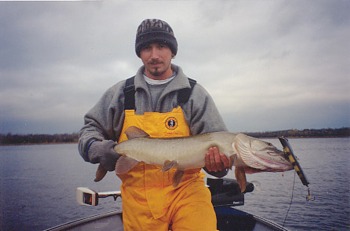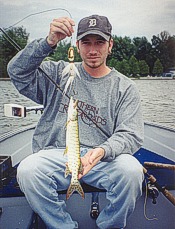| In this issue:
Our
Fishing
Video Site is up and running. If you have hi-speed
internet access
click
here to see some great short fishing video clips. We've
added a few new UNDERWATER Videos
Auld Reekie Lodge
- Whether you pamper yourself with our full meal plan and the
ultimate in comfort in one of our 6 luxury suites, or stay in a
fully equipped 4 star cottage where you can cook your own meals, at
Auld Reekie Lodge we feel
we've got everything you're looking for and more.
Auld Reekie Lodge, as
featured on the Canadian Sportsfishing Show, is a true escape in the
beauty of Northern Ontario's wilderness
Shooting Star Camp
- Fishing Northern Pike, Walleye, Smallmouth
Bass and Lake Trout in Metagama, Northern Ontario in the Spanish
River Country near Elliot Lake. Offering some of northeastern
Ontario's finest hunting and fishing opportunities, rustic fully
equipped log outpost camps located on the shores of the beautiful
upper Spanish river and surrounding lakes.
Bearskin Lodge -
Family holiday resort in Northern Ontario. Fully equipped waterfront
log cabins with screened porches and private docks. Pristine
wilderness lakes at the gateway to Killarney Provincial Park. Hiking
in LaCloche Mountains. Swimming beach, boat and canoe rentals.
Fishing for walleye, pike, large and smallmouth bass. Blueberry and
mushroom picking. Nightly campfires.
|
Does Size Really Matter?
By Justin Hoffman
No matter what kind of fish an angler targets,
deciding on the appropriate size of bait or lure to toss can often
be a difficult decision. Whether it is fishing for largemouth bass,
walleye, musky, or even perch, the question always comes up: "What
size lure should I use?"
Although there is no perfect answer, figuring out
seasonal patterns, and the preferences of various species, can go a
long way in aiding you in your quest for fishing success. Size in
the fishing world certainly does matter, and that's good news for
the intuitive angler.

The Predator/Prey Relationship
Keep in mind when deciding lure size that fish are opportunistic
feeders. When hunger strikes, they will hunt down and attack any
available prey. Be it big or small, a hungry fish will often bite
off more than it can chew, creating some problems when it comes time
to swallow and digest its meal. Although this may seem like a
"kamikaze" approach, and it certainly isn't the norm, studies have
shown that, for the most part, there is rhyme and reason to the
appetite of fish. Generally, fish will chase down and eat prey up to
a fourth of their body size. This is their preference, and if prey
that fits this profile is available, they will stick to these
guidelines. For instance, a 50-inch musky could easily consume a
12-1/2-inch whitefish, or a 20-inch smallmouth would have no trouble
with a 5-inch perch. Remember, however, that these are just
guidelines, and are in no way set in stone.
We must remember that we are dealing with an animal
that has a brain the size of a pea, and will very often make up
their own rules. For example, I've caught musky that have hit lures
that were larger than their own body length, not to mention
largemouth and walleyes that have been caught on huge musky plugs
that dwarfed their bodies!

The reason for establishing a guideline to preferred
size is to give you as an angler a starting point for basic lure
size selection. Keeping your lures within these limits for the
particular specie you are chasing will help in uncovering the first
piece of the puzzle. For instance, if you were out looking for a
20-inch largemouth, a crankbait of around 5 inches would be the
cut-off point during normal conditions. As you will read later,
these rules can be stretched depending on the situations you
encounter.
Match The Hatch
Another important consideration when determining lure size is to
figure out what the forage species are in the particular water you
are targeting. Matching the size and shape of this "natural" food
will ensure that you're throwing baits that will appeal to your
quarry. Here's an example of how this could work with largemouth
bass. If the only available food options to the bass are perch and
shad, a quick look around the shallow areas of the lake will enable
you to see the average size of these baitfish. Match this size and
shape up to your chosen lure, and you will find yourself in the
"strike zone."
The Changing Seasons
The size of prey that a fish will search out can often be determined
by the season. Spring and early summer are a time of renewal, and
fish will generally feed on smaller prey. Most of this is due to
cooler water temperatures, plus an influx of "young of the year"
baitfish that are entering their first year of life. As the summer
warms up, and baitfish continue to grow, the size of prey becomes
larger. An easy way to remember this is, the warmer the water -- the
larger the lure to throw. Digestion processes are aided when dealing
with warmer water, as well -- meaning that the fish will need to eat
more to replenish its food stores.
In order to conserve energy, many fish at this time of year will
consume larger than average prey. This is a key concept to remember.
As summer makes way for fall, larger lures are the rule, not the
exception. Big plugs for musky, and oversized flipping jigs for
bass, are definitely the go-to lures. Fish will be aggressively
attacking bigger baits as they begin to store fat reserves for the
upcoming cold-weather months, and the larger the bait you toss, the
more attention it will garner.
Mouth-To-Mouth Comparisons
The last thing to look at is the mouth of the fish. It only makes
sense that the larger the mouth, the larger the lure you can get
away with using. This may seem a no-brainer, yet anglers often will
group fish together in their appropriate families, oftentimes
forgetting that various species have mouths that can differ greatly.
For example, largemouth bass can handle lures and baits that are
much larger in size in comparison to their cousin, the smallmouth
bass. The same can be said about the crappie when put head-to-head
against the sunfish. Think outside the particular families and
concentrate on the exact species you are interested in pursuing.
Remember: if they can't grasp hold of it, there's no way that the
hooks will find a home.
Next time you are on the water, think carefully
before tying on your favourite lure. Ask yourself: What is the
season? What is the available prey? And of course, visualize the
size of the mouth to see if the lure "fits the yap." Size does
matter to a fish, and to an angler, that knowledge is worth its
weight in gold.
|